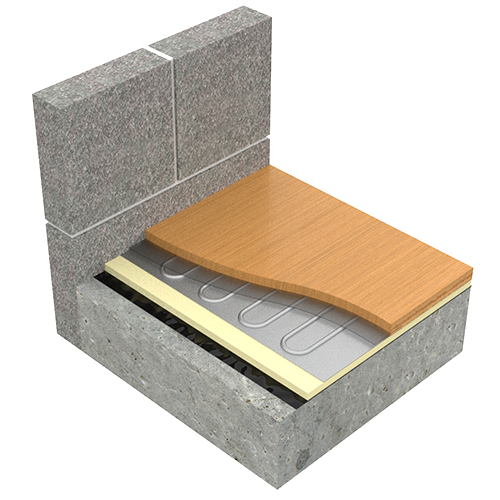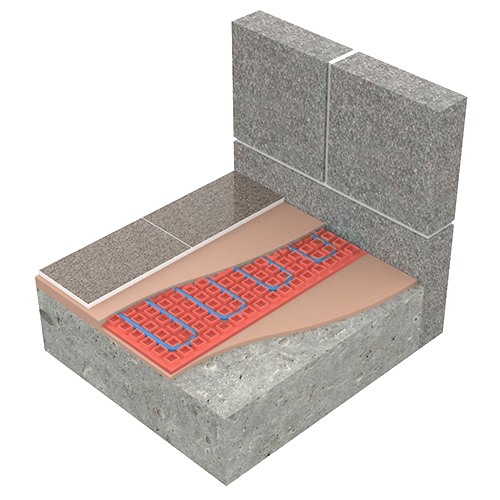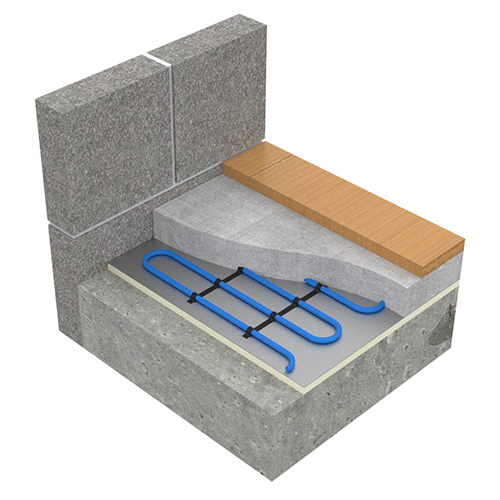Electric
Underfloor
Heating solutions
WHAT IS ELECTRIC UNDERFLOOR HEATING?
Electric underfloor heating is ideal for small rooms such as kitchens and bathrooms. Kitchens and bathrooms tend to have hard floors which can feel very cold underfoot especially with bare feet, which makes electric underfloor heating a great option.
Electric underfloor heating warms an area using a heating wire that is placed under your floor, which then radiates up through your floor surface to warm up your room. This is all controlled using an underfloor heating thermostat, which offers options from simple manual dial control to WiFi control via your smartphone.
The electric underfloor heating system you install will depend on a few factors: the size of the room and how well insulated it is, what the flooring below is like, whether it is insulated, and what type of flooring you'll have on top.


IS ELECTRIC UNDERFLOOR HEATING EFFICIENT?
Electric underfloor heating is highly efficient, with a 100% efficiency rate at the point of use. Since the generated heat is exactly where it is needed, there is no need to transport energy, resulting in every joule of energy being utilized for heat. As a result, every pound spent on running Underfloor Electric Heating is fully converted into heat where it is needed.
COMPARING UNDERFLOOR HEATING SYSTEMS
| Underfloor Heating System | Suitability | Running Cost | installation time & cost |
|---|---|---|---|
| Warm Water Underfloor Heating | It can be used for all types of projects, including new construction, renovation, and single rooms. | Low running costs. | Higher upfront cost compared to electric, but is cheaper to run. Installation time varies depending on the project. |
| Electric Underfloor Heating | Recommended for use in smaller spaces, like a bathroom, due to running costs. | More expensive to run than water underfloor heating systems. | Installation is easier, can be installed in a single room in only a few hours. |
What is the Best Electric Underfloor Heating?
Underfloor heating mats SOLUTIONS
Underfloor heating mats are the most popular electric floor heating system. The mats are simply rolled out, cut and turned to suit the shape of the floor, with the added feature that the cable can be removed from the mat for those really awkward obstacles.
This system is ideal for kitchens, living rooms and conservatories. Power outputs are typically 100w, 160w and 200w.
 SUITABLE FLOOR CONSTRUCTIONS
SUITABLE FLOOR CONSTRUCTIONS
 SUITABLE FLOOR FINISHES
SUITABLE FLOOR FINISHES
NOTES:
- Insulation is optional underneath the heating mats but it will reduce the warmup time and reduce running costs so it should always be used if possible.
- If the floor finish is tiles, then you can either use a flexible tile adhesive directly on the heating mat or self-level over the heating mat then fix the tiles with flexible tile adhesive.
- If you’re going to use underfloor heating mats under wood, vinyl or carpet, then you will need to use a levelling compound over the mat before installing the floor finish.


UNDERWOOD / LAMINATE / CARPET / VINYL HEATING MATS SOLUTIONS
Our comprehensive range of aluminium heating mats are designed to be installed under engineered woods, laminate floors, carpets and vinyl floors.
The 500mm wide foil heating mats are fully earth screened and fully comply with the current electric & building regulations.
 SUITABLE FLOOR CONSTRUCTIONS
SUITABLE FLOOR CONSTRUCTIONS
 SUITABLE FLOOR FINISHES
SUITABLE FLOOR FINISHES
NOTES:
- It is essential that a 5mm XPS insulating underlay (such as Izotherm) is used under the heating mats.
- Your laminate or engineered wood flooring can be laid directly on to the system without the need for any other underlay.
DECOUPLING MEMBRANE AND CABLE HEAT SOLUTIONS
Decoupling floor heating systems solves 2 complications in one solution. Combining a decoupling mat (sometimes called anti-crack / uncoupling mat) with a heating cable.
The result is a faster to install solution which normally saves time and money.
 SUITABLE FLOOR CONSTRUCTIONS
SUITABLE FLOOR CONSTRUCTIONS
 SUITABLE FLOOR FINISHES
SUITABLE FLOOR FINISHES
NOTES:
- You must use flexible tile adhesive to secure the HeatBase mat to the floor and to fix the tiles on top of the heating cable / Heatbase mat.
- As you are using HeatBase, you will not need any other decoupling membrane.


UNDERFLOOR LOOSE WIRE SOLUTIONS
Loose wire systems are the perfect solution for more awkward floors with obstacles, such as bathrooms.
The cable is supplied on a drum and when installed is spaced evenly over the floor, this offers the flexibility to negotiate obstacles and space the cable evenly, no matter the shape of the room.
 SUITABLE FLOOR CONSTRUCTIONS
SUITABLE FLOOR CONSTRUCTIONS
 SUITABLE FLOOR FINISHES
SUITABLE FLOOR FINISHES
NOTES:
- Insulation is optional underneath the heating cables but it will reduce the warmup time and reduce running costs so it should always be used if possible.
- If the floor finish is tiles, you can either use flexible tile adhesive directly on the cable or self -level over the heating cable then fix the tiles with flexible tile adhesive.
- If you're going to use heating cables under wood, vinyl or carpet, then you will need to use a self levelling compound over the cable before installing the floor finish.
IN-SCREED FLOOR HEATING SOLUTIONS
These cables are typically used for new builds, extensions and conservatory projects, as they are only suitable if you are installing a new floor screed.
In screed cables installed directly on your rigid insulation (e.g. Celotex or Kingspan) and covered with a floor screed compliant with building regulations (50-65mm)
 SUITABLE FLOOR CONSTRUCTIONS
SUITABLE FLOOR CONSTRUCTIONS
 SUITABLE FLOOR FINISHES
SUITABLE FLOOR FINISHES
NOTES:
- Insulation should be rigid PIR.
- Some insulation / screed combinations require a vapour barrier to be installed directly on the insulation before you install the cable and lay the screed.
- To comply with building regulations, you should use a minimum of 65mm sand / cement screed or 50mm pumped screed.
